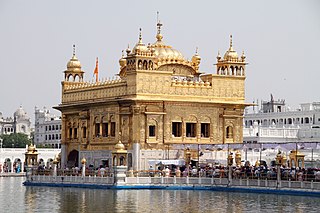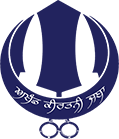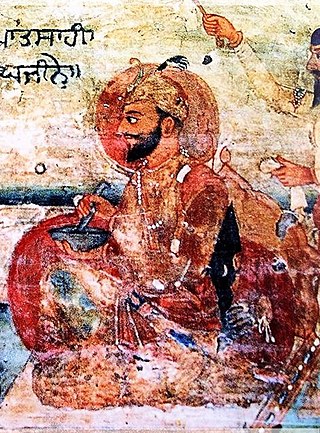
Sikhism is an Indian religion, and is a philosophy, that originated in the Punjab region of India, around the end of the 15th century CE. It is one of the most recently founded major religious groups and stands at fifth-largest worldwide, with about 25–30 million adherents.

Guru Gobind Singh was the tenth and last human Sikh Guru. He was a warrior, poet, and philosopher. In 1675, at the age of nine he was formally installed as the leader of the Sikhs after his father Guru Tegh Bahadur was executed by Emperor Aurangzeb. His four biological sons died during his lifetime – two in battle and two executed by the Mughal governor Wazir Khan.

Khalsa refers to both a community that considers Sikhism as its faith, as well as a special group of initiated Sikhs. The Khalsa tradition was initiated in 1699 by the Tenth Guru of Sikhism, Guru Gobind Singh. Its formation was a key event in the history of Sikhism. The founding of Khalsa is celebrated by Sikhs during the festival of Vaisakhi.
The following outline is provides an overview of Sikhism, or Sikhi.

The Dasam Granth is a collection of various poetic compositions are alleged to be the works of Guru Gobind Singh. Many scholars have debated the authenticity of the Dasam Granth. The text enjoyed a parallel status but recognized to be below the Adi Granth, or Guru Granth Sahib, in the eighteenth and nineteenth centuries and were installed side by side on the same platform. The Dasam Granth lost favor during the colonial period when reformist Singh Sabha Movement scholars couldn't contextualize the reworkings of Puranic stories or the vast collection of 'Tales of Deceit' Sri Charitropakhyan.
The standard edition of the text contains 1,428 pages with 17,293 verses in 18 sections. These are set in the form of hymns and poems mostly in the Braj language, with some parts in Avadhi, Punjabi, Hindi and Persian. The script is written almost entirely in Gurmukhi, except for the Guru Gobind Singh's letters to Aurangzeb—Zafarnama and the Hikaaitaan—written in the Persian alphabet.

Kaur, sometimes spelled as Kour, is a surname or a part of a personal name primarily used by the Sikh and some Hindu women of the Punjab region. It is also sometimes translated as 'lioness', not because this meaning is etymologically derived from the name, but as a parallel to the Sikh male name Singh, which means 'lion'.

The Nihang or Akali, also known as Dal Khalsa, is an armed Sikh warrior order originating in the Indian subcontinent. Nihangs are believed to have originated either from Fateh Singh and the attire he wore or from the "Akal Sena" started by Guru Hargobind. Early Sikh military history was dominated by the Nihang, known for their victories where they were heavily outnumbered. Traditionally known for their bravery and ruthlessness in the battlefield, the Nihang once formed the irregular guerrilla squads of the armed forces of the Sikh Empire, the Sikh Khalsa Army.

The Akhand Kirtani Jatha, alternatively romanized as the Akhand Keertanee Jathaa and abbreviated as AKJ, is a jatha and sect of Sikhism dedicated to the Sikh lifestyle. The Jatha follows a strict discipline in keeping the Rehat of Guru Gobind Singh. They also enjoy an active style of Keertan recited by Sikhs in a collective manner in front of Guru Granth Sahib. This style of Keertan is relatively simple, and the entire congregation devotionally participates in singing along.

Panj Pyare refers to a gathered ad hoc quintet of five baptized (Amritdhari) Khalsa Sikhs who act as institutionalized leaders for the wider Sikh community.

The principal Sikh scripture is the Adi Granth, more commonly called the Guru Granth Sahib. The second most important scripture of the Sikhs is the Dasam Granth. Both of these consist of text which was written or authorised by the Sikh Gurus.
The principles of Sikhism state that women have the same souls as men and thus possess an equal right to cultivate their spirituality with equal chances of achieving salvation. Women in Sikhism participate in all religious, cultural, social, and secular activities including lead religious congregations, take part in the Akhand Path, perform Kirtan, perform Gatka and work as a Granthis.
Ravidassia or the Ravidas Panth is a religion based on the teachings of Guru Ravidas. It was considered a sect within Sikhism until 2009. The Sikh gurus and the Guru Granth Sahib are considered reverential, but not central figures in the religion.
Jat Sikh are an ethnoreligious group and a subgroup of the Jat people and the Sikh religious group from the Indian subcontinent. They are one of the dominant communities in the Punjab, owing to their large land holdings.
Sahej Paath or Sadharan Paath or even Khula Paath, literally means easy or simple recitation. It is a paath (recitation) which may be started and ended at any time; with as many or as few people participating as desired. The recitation of the Guru Granth Sahib is started at the beginning of the Granth Sahib and the whole of the 1430 pages of the Guru Granth is read in a slow fashion over from seven days to, in some cases, over several months. It is a slow, intermittent, non-regular, and non-urgent reading of the whole of the Guru Granth Sahib. Any paath which exceeds a week's length is referred to as a Sahej Paath.
A Hukamnama, in modern-times, refers to a hymn from the Guru Granth Sahib which is given as an injunction, order, or edict to Sikhs. It also refers to edicts issued by the contemporary Takhts. In the historical sense, it was used to refer to an issued injunction, order, or edict given by one of the Gurus of Sikhism or their officiated followers and associates during their lives.
The following list consists of concepts that are derived from both Sikh and Indian tradition. The main purpose of this list is to disambiguate multiple spellings, to make note of spellings no longer in use for these concepts, to define the concept in one or two lines, to make it easy for one to find and pin down specific concepts, and to provide a guide to unique concepts of Sikhism all in one place.
The Sikhs are adherents to Sikhism, the fifth largest organized religion in the world, with around 25 million adherents. Sikh History is around 500 years and in that time the Sikhs have developed unique expressions of art and culture which are influenced by their faith and synthesize traditions from many other cultures depending on the locality of the adherents of the religion. Sikhism is the only religion that originated in the Punjab region with all other religions coming from outside Punjab. All the Sikh gurus, many saints, and many of the martyrs in Sikh history were from Punjab and from the Punjabi people. Punjabi culture and Sikhism are mistakenly considered inseparably intertwined. "Sikh" properly refers to adherents of Sikhism as a religion, strictly not an ethnic group. However, because Sikhism has seldom sought converts, most Sikhs share strong ethno-religious ties, therefore it is a common stereotype that all Sikhs share the same ethnicity. Many countries, such as the U.K., therefore misconcievingly recognize Sikh as a designated ethnicity on their censuses. The American non-profit organization United Sikhs has fought to have Sikhs included on the U.S. census as well, arguing that Sikhs "self-identify as an 'ethnic minority'" and believe "that they are more than just a religion".
Sikhism was founded in Punjab in 1469 by Guru Nanak on the foundations that everyone is equal, regardless of caste, age, or gender. Both men and women are supposed to follow the Five Ks: Kesh, Kangha (comb), Kara, Kachera and Kirpan, and there was never a distinction between what a woman should be allowed to do versus a man at theological level. Men and women are treated equally in the temple (gurdwara), and everyone eats and prays side-by-side. Both men and women are meant to carry the Kirpan with them as they are responsible for their own physical protection, and should not depend on others. Sikhs are strictly against the caste system and many chose to use Kaur or Singh as a last name to push against the problematic caste system in India. There is only one god (Waheguru) in Sikhism and they are without form or gender, and everyone is equal in the eyes of God. Many Sikh women believe that this absence of assignment of code of conduct for a woman versus a man proves that their religion is historically committed to gender equality. Presently, the culture does not always follow these traditions and equality is often more true in ideals rather than daily practice. According to Kiman Kaur: "It is essential to take into account the diverse Kaur narratives in order to critically understand the violence Sikh womxn experience due to religious, ethnic, and gender minoritization through enabling more intersectional conversations."

Amrit Sanskar also called Amrit Parchar, Amrit Sanchar, Khande di Pahul, or Khande Batte di Pahul is one of the four Sikh Sanskaars. The Amrit Sanskar is the initiation rite introduced by Guru Gobind Singh when he founded the Khalsa in 1699.










